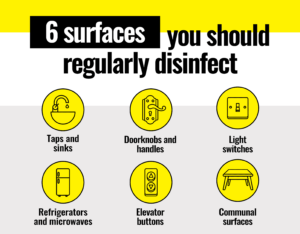In busy spaces like offices, regularly cleaning and disinfecting surfaces that are frequently touched should be a core part of your cleaning routine. In fact, to reduce the spread of viruses like COVID-19, Safe Work Australia recommends that these types of surfaces – such as door handles and taps – be cleaned and disinfected at least once per day.
However, many of us overlook cleaning and disinfecting or rush our routines to get them over and done with. While we may think that we’re doing the right thing to stop the spread of germs, eliminating bacteria and viruses from hard surfaces isn’t simply a case of ‘spray and wipe’.

What is disinfectant “dwell time”?
Disinfectants are designed to kill germs on hard surfaces. The mechanism that they use to do this differs between disinfectants, but all of them require a certain amount of contact time to eliminate the germs. This is the “dwell time”, which can also be known as the:
- Kill time,
- Contact time, or
- Action time.
If you spray a surface with disinfectant and then wipe it straight away, you may not be giving the solution enough time to work. Those few seconds that the disinfecting agent has been in contact with the surface are unlikely to have killed many bacteria or viruses. The surface that you think you’ve disinfected may not be so free of germs after all!
Always read the label
You will always be able to find a recommended dwell time on your disinfectant’s label. Look for sentences like “Apply to the surface and allow for a contact time of X”. It’s important that the entire area remains wet during this time frame. If your disinfectant dries before its recommended dwell time, apply more.
The dwell time listed on a product’s label means that it has been proven to kill 99.99% of its claimed bacteria and viruses in that amount of time.
*Coronavirus (incl. SARS-CoV-2), vaccinia viruses.
